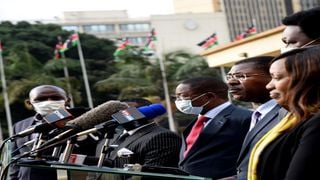
Senate mediation committee members at a press briefing in August where they announced they would table a report on revenue allocation.
| Diana Ngila | Nation Media GroupCounties
Premium
Revenue fight that left counties on brink of collapse in 2020
The year 2020 will be remembered for the long-drawn-out fight over how to allocate Sh316.5 billion revenue to counties, which left county governments across the country on the brink of collapse.
The stalemate led to salary delays, a freeze in projects, delayed payments to suppliers, and paralysis in hospitals.
But the stand-off began as early as last year September when Senators and MPs disagreed on the amount to be allocated to counties as the equitable share.
Senators had sided with the Commission on Revenue Authority (CRA) in pushing for Sh314.7 billion for the counties while MPs insisted on Sh291 billion.
Governors would then move to the Supreme Court to challenge the division of shareable revenue before a compromise of Sh316.5 billion was settled on.
Another impasse
However, another impasse ensued and this time on how to share the billions among the 47 county governments.
Even after the Division of Revenue Bill, 2020 was published in April, it took until September for the Senate to agree on a new revenue sharing formula before the National Assembly approved it in early October.
This paved the way for President Uhuru Kenyatta to assent to the Bill, bringing to an end the five-month protracted war on the new revenue sharing formula to guide allocation for the next five years.
The impasse left counties clutching at straws to stay afloat with staff in the 47 county governments going without salaries for months.
A halt
County operations almost came to a halt with counties going without funds from the start of the new financial year on July 1, 2020.
The County Allocation of Revenue Act (Cara) divides the revenue raised nationally and allocated to county governments through the Division of Revenue Act among the 47 counties.
What started as “one man, one shilling” and “one kilometre, one shilling” hardline stance soon degenerated into a full-blown crisis with senators sharply divided over the new revenue sharing formula.
With the proposed formula by CRA putting more weight on population and leaning towards the “one man, one shilling” faction, a battle ensued as counties that stood to lose should the CRA formula be adopted dug in.
Larger populations
The CRA formula would mean that counties with larger populations will emerge as the biggest beneficiaries while those with low numbers would lose.
The latter were 19 counties drawn mainly from the North, Coast and Lower Eastern counties who stood to lose a cumulative Sh42 billion while the rest of the 28 counties were to gain.
There would be three formulas put forward, one by the Finance and Budget committee, another by nominated Senator Petronilla Were and one by Meru Senator Mithika Linturi.
As the tussle raged, counties felt the heat, with most abandoning all development projects to focus on recurrent expenditure with the little cash available.
Nairobi County, for instance, had to depend on Vote on Accounts to fund its recurrent expenditure.
Stop services
In September, the Council of Governors (CoG), after having had enough, threatened to shut down county services and send home staff if the revenue sharing stalemate persisted.
The standoff at the Senate had resulted in a three-month delay in the release of equitable revenue share due to county governments, making it impossible for counties to pay salaries and allowances for health workers amid the Covid-19 pandemic.
“If the prevailing situation persists, effective Thursday, September 17, 2020, counties will have no choice but to shut down,” CoG chairperson Wycliffe Oparanya warned.
A 12-member Senate mediation committee was formed to try to bring an end to the stalemate with no deal anywhere in the offing with counties failing to get their monthly disbursements for July, August and September.

From left: senators John Kinyua, Irungu Kangata and Samson Cherarkey celebrate on September 17, 2020 after the passing of the county revenue-allocation formula.
But with pressure by governors mounting, it was tenth time lucky for the senators with a deal finally being struck on September 29, 2020 after the committee unanimously agreed on a way forward.
A week later, the Senate adopted the committee’s report through a resolution, paving the way for dispatch of the funds to the cash-strapped counties after President Kenyatta assented to the Act on October 8.
The deal saw a total of at least Sh369.8 billion promised to counties as from the 2021/2022 financial year to 2024/25.
For the financial year ending June 30, 2021, Sh316.5 billion would be the equitable revenue share, Sh13.73 billion in conditional grants, Sh9.43 billion from the road maintenance/fuel levy as well as Sh30.2 billion in loans and grants.
The National Treasury later disbursed Sh52.2 billion to the county governments, being their equitable share for July and August 2020, saving most counties from financial doldrums.





